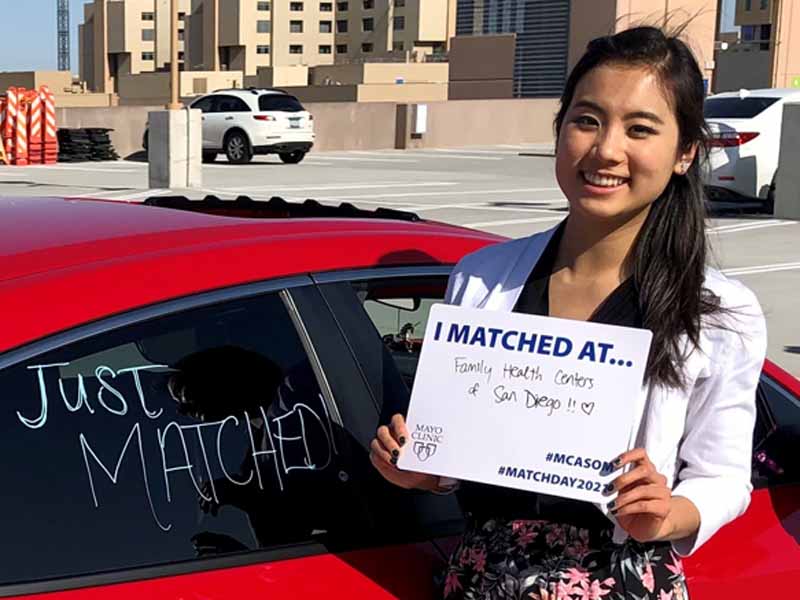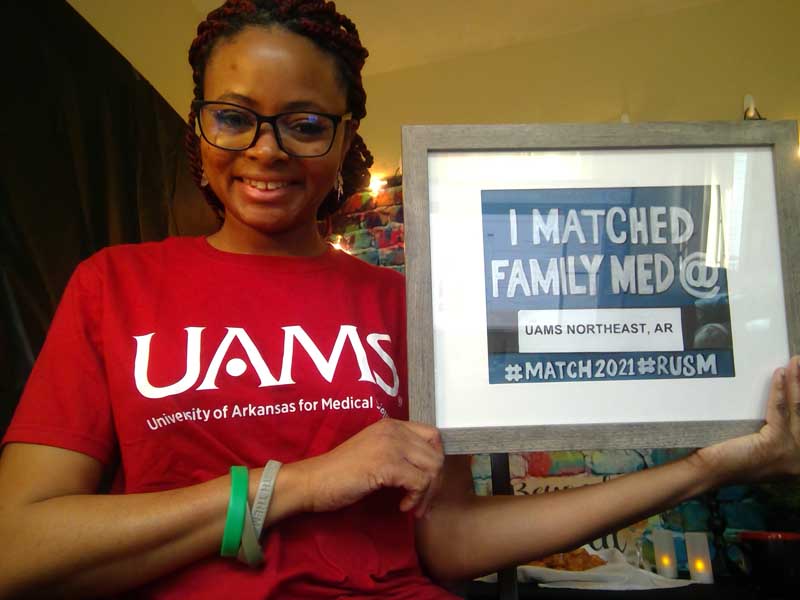Match Day Is a Record-breaker for Family Medicine
AAFP President: Students Recognize ‘Vital Role’ of Specialty
March 19, 2021, 1:15 p.m. News Staff — The COVID-19 pandemic forced medical students and residency programs into a completely virtual interview process this Match season, but that challenging experience didn’t dampen enthusiasm for family medicine. When results from the National Resident Matching Program Main Residency Match were released on March 19, they showed that 4,493 applicants had matched into family medicine, marking 12 years of growth for the specialty and the 10th consecutive year that an all-time record number of students had matched into family medicine.

“We’re pleased with the results,” said Karen Mitchell, M.D., director of the AAFP’s Medical Education Division. “There were significant concerns about how the Match would turn out after the challenges of the past year. Looking at the numbers, students and programs were able to find each other successfully, and we ended up seeing growth and stability across the board for family medicine.”
[Photo: Crystal Huang, a fourth-year student at the Mayo Clinic Alix School of Medicine matched with the family medicine residency at the Family Health Centers of San Diego. Huang was part of the first class at Mayo’s campus in Phoenix and Scottsdale, Ariz.]
A net of 21 more family medicine residency programs than last year participated in the Match, Mitchell said. Overall, the specialty offered 4,844 positions, 159 more than the year prior, and filled 158 more. This year,
- U.S. seniors from allopathic medical schools accounted for 1,623 positions, up from 1,557 last year;
- U.S. seniors from osteopathic medical schools accounted for 1,443 positions, up from 1,399; and
- international medical graduates accounted for 1,225 positions, up from 1,193.
Reflecting the Nation’s Needs
AAFP President Ada Stewart, M.D., of Columbia, S.C., said COVID-19 has shown students and others the essential need for family physicians, who have played a wide range of roles in fighting the pandemic.
“We saw the impact family medicine had in our communities and the nation during this pandemic,” Stewart said. “We’re on the front lines taking care of patients. More family physicians means better access to care and better health outcomes for our country. I’m so happy and proud to be a family physician and to welcome the next generation of family doctors to our specialty.”
Stewart said the AAFP and family physicians also are playing a key role in addressing health equity, an issue that resonates with many students.
“We play an integral part of health care in our nation in so many ways, including standing up for our patients, communities and the need for high-quality and equitable health care,” she said. “The next generation of family physicians recognizes the vital role our specialty plays in addressing social issues — including health equity and racism — and the impact those issues have on health. I’m excited. It’s a great day.”
.jpg)
Family medicine’s fill rate was 92.8%, but when a more comprehensive report from the NRMP is released, it’s expected to reflect that more than 4,800 family medicine residency positions have been nabbed by students and graduates. The NRMP’s Supplemental Offer and Acceptance Program that took place this week is anticipated to have filled nearly all of the 351 family medicine slots that were unfilled in the main residency Match. For comparison, in the 2020 SOAP, 337 family medicine positions were available, and 294 filled.
The military match took place in January. However, results of that process — which usually results in more than 100 students matching to family medicine — have not been made public.
Mitchell said family medicine’s growth is consistent with the needs of U.S. patients because family physicians represent the majority of the primary care physician workforce and mirror the geographic distribution of the U.S. population more closely than other specialties. Family physicians often serve in rural and underserved communities, treating a more diverse population of patients than other specialties. As leaders in their communities, family physicians have an important role in raising awareness about health disparities and helping patients address social and economic drivers of health inequities, Mitchell said.

“It’s clear that family medicine aligns with students’ growing passion for things like strong patient relationships, social justice, and versatility and adaptability in a career,” Mitchell said. “Both the number of family medicine residency positions and the number of U.S. students and graduates matching into family medicine increased this year, which is a win for our country’s health care. We need more family physicians to curb the primary care shortage in the U.S., and every year of family medicine growth in the Match gets us closer to that goal.”
[Photo: Priscilla Auguste, M.H.S., a fourth-year student at Ross University School of Medicine, based in Barbados, matched with the family medicine residency at the University of Arkansas for Medical Sciences Northeast in Jonesboro.]
Accelerating Growth
The AAFP has a strong history of supporting the future family medicine workforce by offering free medical student membership and supporting a national network of family medicine interest groups at medical schools. This year, the AAFP has expanded its efforts to an even earlier point in student development through a partnership with HOSA Future Health Professionals, a U.S. Department of Education-recognized high school and post-secondary student organization that promotes career opportunities in health care. The AAFP and HOSA developed the Family Medicine Career Test, which launched this month and encourages high school students to learn about opportunities in and the impact of family medicine.
More information about this growing national partnership, as well as opportunities for AAFP members to get involved in their communities, will be announced in the coming months.